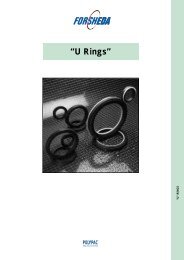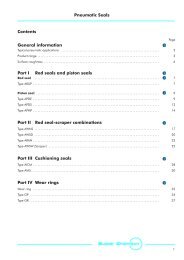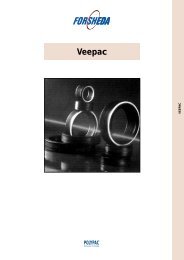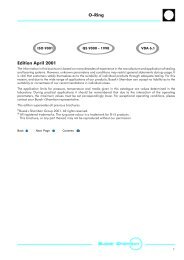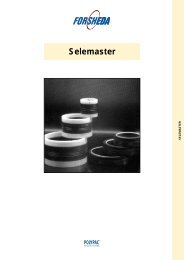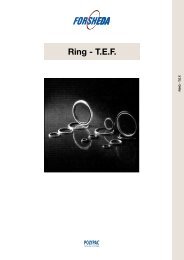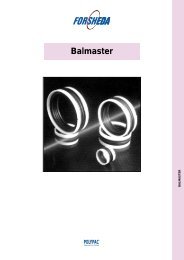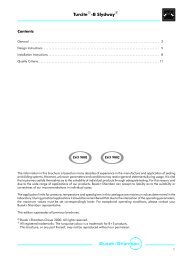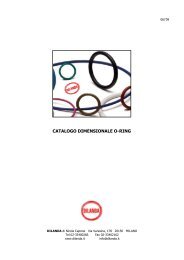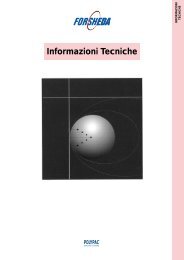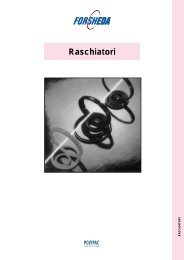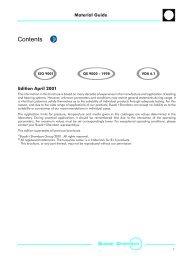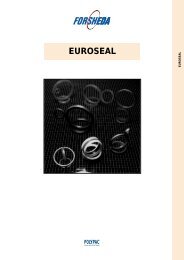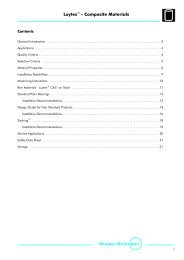Rotary Seals - Dilanda.it
Rotary Seals - Dilanda.it
Rotary Seals - Dilanda.it
You also want an ePaper? Increase the reach of your titles
YUMPU automatically turns print PDFs into web optimized ePapers that Google loves.
Turcon ® Roto Glyd Ring ®<br />
Frictional power<br />
Guide values for the frictional power can be determined<br />
from the graph in Figure 82. They are shown as a function<br />
of the sliding speed and operating pressure for a shaft<br />
diameter of 50 mm w<strong>it</strong>h an oil temperature of 60° C. At<br />
higher temperatures, these application lim<strong>it</strong>s must be<br />
reduced.<br />
Guide values for other shaft diameters can be calculated<br />
using the formula:<br />
P P50 x (<br />
Frictional power P 50<br />
Figure 82<br />
d<br />
50 mm<br />
400<br />
W<br />
300<br />
200<br />
100<br />
0<br />
) [W]<br />
1 m/s<br />
0 10 20 MPa 30<br />
Pressure<br />
0.5 m/s<br />
Frictional power for<br />
Turcon ® Roto Glyd Ring ®<br />
Shaft dia. 50 mm<br />
0.25 m/s<br />
0.15 m/s<br />
The guide values apply for constant operating cond<strong>it</strong>ions.<br />
Changes in operating cond<strong>it</strong>ions such as pressure<br />
fluctuations or alternating directions of shaft rotation can<br />
result in considerably higher friction values.<br />
Application examples<br />
The Turcon ® Roto Glyd Ring ® is the preferably used as a<br />
double acting rotary seal for hydraulic and pneumatic<br />
equipment in sectors such as:<br />
- <strong>Rotary</strong> distributors<br />
- High pressure valve stems<br />
- Manipulators<br />
- Pivoting motors in mobile hydraulic and machine tools<br />
- Hydraulic motors<br />
Application lim<strong>it</strong>s<br />
The maximum application data for temperature, pressure<br />
and speed given in this catalogue have a mutual effect on<br />
one another and can thus not be explo<strong>it</strong>ed simultaneously.<br />
Seal performance is further influenced by such factors as<br />
lubrication capabil<strong>it</strong>y of the sealed medium and heat<br />
dissipation in the hardware, <strong>it</strong> follows that testing should<br />
always be made.<br />
W<strong>it</strong>h good lubrication, the following pv value can be<br />
assumed as guide:<br />
Turcon ® Roto Glyd Ring ® : up to pv = 2.5 MPa · m/s<br />
The value must be reduced for diameters < 50 mm.<br />
Lead-in chamfers<br />
In order to avoid damage during installation, lead-in<br />
chamfers and rounded edges must be provided on the<br />
housing and on the rod (Figures 83 and 84). If this is not<br />
possible for design reasons, a separate installation tool is<br />
recommended.<br />
The minimum length of the lead-in chamfer depends on<br />
the profile size of the seal and can be seen from the<br />
following tables. If concentric<strong>it</strong>y between the parts is not<br />
ensured during installation the lead-in chamfers must be<br />
increased correspondingly.<br />
For the surface qual<strong>it</strong>y of the lead-in chamfer, the same<br />
recommendations apply as given for the sealing surfaces in<br />
Table LIX.<br />
190<br />
Latest information available at www.busakshamban.com<br />
Ed<strong>it</strong>ion April 2006



